Types of Vegetables and Fruits
In botany, a fruit tree is the actual seed-bearing structure within flowering plants which are typically formed in the ovaries during flowering. A fruit tree differs from other plants in that it is not self-supporting and relies on the support of supporting roots for growth and reproduction. The fruit of a berry tree is called a berry, whereas the fruit of a pine tree is called a pineapple. There are literally hundreds of different species of fruit trees, each with its own characteristics and geographic location.

Many fruits form within a year of hatching. Some grow up to six or more meters tall. These fruits include apples, apricots, pears, blackberries, strawberries and gooseberries. Many of these fruits form on the undersides of leaves. Other fruits form at the base of a fruit, on the outer side of the ovary.
When a fruit reaches full maturation, the fruit begins to dry out and fall. This results in the drying up of the seeds. After about twelve months of drying, a fruit begins to bruise, flake and peel. It also may begin to curl up. The process of breaking down a fruit begins at this point and continues throughout the maturity of the fruit.
A fruit’s size, shape and location can all affect what type of fruit it will be, and how long it will last. A small fruit will be smaller in size and have a low concentration of seeds. A larger fruit, such as a berry, will be of a higher concentration of seeds and will be larger in size and will have a higher concentration of sweet pulp as well.
Flowering plants are made up of primary and secondary parts. The primary parts are the flowers or stamens and the secondary parts are called the petals or halogens. The ovaries form the part of a flower that produces the sugars that make up the flowers. The ovule is the egg cell from which a flower grows. The endosperm is the part of a flower that carries the pollen to and fro.
There are two main types of botanical fruits and vegetables. Culinary and ornamental plants are not to be confused with a plant product. The main difference is that culinary fruits and vegetables have seeds while ornamental/designer vegetables have no seeds and are developed through planting.
Some fruits have been bred so that they will retain more vitamin C than other fruits. These fruits and vegetables include oranges, strawberries, peaches, nectarines, cantaloupe and grapefruits. They also have high amounts of antioxidants that help protect the body from harmful free radicals that can cause damage in the body and cause cancer.
Aggregated fruits or vegetables are fruits with a string of seed in the middle. The seed can be purchased in a variety of forms including berry, fruit bar, smoothie and juice. The drupe is made by taking the drupe fruit, cutting it into manageable pieces and then grinding it. It is a very thick and chunky piece of fruit. It has a very nice flavor, full-bodied and slightly fruity.